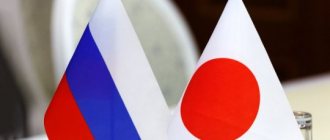Telephone communications
In 2003, Japan began the systematic elimination of pay phones installed in public places.
The rapid spread of cellular communications has made their preservation and maintenance unprofitable. Last year alone, the Japan Telephone Corporation lost $300 million on this, whereas previously this item in its budget had invariably generated good profits. In the mid-80s, when the craze for mobile phones began, there were about a million red telephone booths in the Land of the Rising Sun. In any city, they caught your eye more often than mailboxes. These booths became firmly established in everyday life, because they were used not only for telephone conversations. In the entertainment districts of Tokyo (Shimbashi, Shibuya, Shinjuku), it was on their walls that the “night butterflies” of the capital stuck their business cards, and near subway and train stations students hang up their advertisements, offering to prepare schoolchildren for exams. And how many opportunities there are for confidential contacts! After all, every pay phone has a number that you can call at the appointed time. From any telephone booth you could call not only to another city, but also to any country, if you made a deposit in advance.
Despite the fact that telephone booths have been dismantled in many places, there are still many payphones in Tokyo. At the same time, several groups of them are distinguished:
1.) Green or gray machines (they have the inscription ISDN on them) are long-distance telephones and they work only with special telephone cards of various denominations, which can be bought at almost any hotel. 2.) Intercity machines – blue or yellow . They also accept cards, but can also accept coins - 100 yen and 10 yen. 3.) In-city telephones (they are smaller in size compared to others) - red - operate on coins only and only accept 10 yen.
How to use the machines is shown inside each booth. If you need to call from Tokyo to Moscow, for example, it can cost from 140 yen to 270 (it will all depend on what time of day the call is made).
To call Moscow from a machine, dial 001 - this is an intercity connection, then dial 7 - this is the Russian code, and then 495 - this is the Moscow code, and then your number.
When calling a Japanese landline phone, you must dial 8 – 10 – 81 – <area code> – <call number>. The city code must be entered without the first “0” in the code.
Some city codes: Akita - 188, Ashikaga - 284, Wakayama - 734, Imabari - 898, Yokohama (Aomori) - 175, Yokohama (Kanagawa) - 45, Kawasaki - 44, Kagoshima - 992, Kyoto - 75, Kitakyushu - 93, Kobe – 78, Masuda – 856, Mito – 292, Nagasaki – 958, Nagoya – 52, Niihama – 897, Okayama – 86, Omuta – 944, Osaka – 6, Sapporo – 11, Sendai – 22, Shiogama – 22, Takamatsu – 878, Takaoka - 766, Chiba - 43, Tokyo - 3, Tokuyama - 834, Fukuoka - 849, Fuchu - 423, Hakodate - 138, Hiroshima - 82, Ebino - 984, Yamaguchi - 839. In some cases, the city code is written with the addition in front of it are the numbers “0”, for example: Sapporo - 011.
Japan announced the start of work on the launch of 6G mobile communications
The big news of last week: Japan announced the launch of a program to develop sixth generation mobile communications (6G). Ogonyok found out what opportunities this new horizon opens up.
Alexey Frolov,
Center for Scientific and Engineering Computing Technologies for Problems with Large Data Arrays, Skolkovo Institute of Science and Technology. Recorded by Elena Babicheva
This year, the world expects a massive transition to the 5G standard - the fifth generation of cellular communications. They have been trying it out for several years now: at the end of 2018, one of the companies launched a 5G network in the USA, at the beginning of 2019, new generation communications began working in South Korea and some cities in Switzerland, then - in test mode - in several cities in China . According to analysts, by the end of 2021, the total number of connections to this technology around the world will reach 205 million, of which the United States will account for 28 million and China - 143 million. In five years (again according to forecasts), the United States will increase its presence in this network has up to 318 million connections, and the main share will come from China, which is expected to have more than a billion connections to this technology, which will automatically make it a leader in this direction.
And now Japan has joined the technology race, unexpectedly announcing the start of work on the launch of 6G mobile communications. Neither more nor less. For what? To prevent Chinese technological dominance.
“In the near future, dominating wireless communications will be tantamount to ruling the world,” said the American politician and former Speaker of the House of Representatives, Republican Newt Gingrich. And perhaps these are the considerations that guide the Japanese Ministry of Internal Affairs and Communications. It hopes to take revenge and is already forming an expert community, including scientists from the University of Tokyo and representatives of large technology companies, to prepare for the launch of new mobile communication technology.
Limits to growth
For the average user, the key factor of all known “tiers” of G is the data transfer speed: each new generation is “faster” than the previous one.
The most advanced today are fifth generation networks, in which the maximum speed can reach 35 Gbit/s. So, a fantastic breakthrough is expected from the sixth generation announced by the Japanese - in 6G networks, data transfer speeds can range from 100 Gbit/s to 1 Tbit/s.
Speeds are important to support virtual reality technology and transmit large video streams, high-resolution videos (higher speeds improve video quality). In addition, super speeds will help support advanced services, such as virtual and augmented reality, for example. Such a task had never existed before, and the indicators offered by the 5G generation, which were achieved through the use of complex signal detection and decoding algorithms, were considered the height of perfection. Now, however, a horizon has been announced whose characteristics are simply fantastic. Although we must keep in mind: today the speeds are so high that the current generation of cellular communications is approaching the limits of what is possible, and the next technological breakthrough promised by the Japanese reaches such limits. That is, it will most likely not be possible to increase the data transfer speed further (say, a thousand times) with existing technologies.
When will 5G appear in Russia?
And why? After all, one of the key reasons for the transition from 4G cellular networks to 5G networks was not the transmission speed, but the need to support machine-to-machine communication. And the spread and development of this technology in the world fits into two key scenarios.
First of all, it is URLLC (Ultra-reliable and low-latency communication) - ultra-reliable low-latency communication, which is important for applications such as the industrial Internet, smart grids, remote surgery and intelligent transport system. A classic example is an unmanned vehicle, where ultra-reliable transmission is important (without it, there is a high probability of a collision or other emergency).
Another scenario that 5G envisions is related to the massive connection of devices to the Internet (Massive machine type communication). For example, the “Internet of Things” implies the direct connection and interaction of different devices with each other with virtually no human intervention. In the 5G era, new applications are being developed to serve a huge number of such “things”. Let’s imagine the situation of a very dense network, when there are, say, 200 thousand sensors per square kilometer. And we need to take a signal from everyone and maintain this connection. Traffic is quite difficult to predict; it is sporadic. In this situation, there is no need for large volumes of data transfer, but it is important to maintain the maximum level of connections.
These scenarios are unlikely to change dramatically with the advent of 6G.
Evolution without revolution?
The Japanese application sounded loud. But in fact, even the concept of 6G as such does not exist yet. Scientists are still wondering how to build this network. Although there is no doubt that new requirements will appear soon. For example, to increase the data transfer rate, it is necessary to make fewer cells, so that the distance between transmitters is shorter and the network is denser. In addition, the algorithm for creating this network will, of course, still be further developed, and the 6G network itself will be improved.
But still: there will not be such a significant gain as when moving from the previous “tiers” of G to new ones (up to 5G).
The transition from 3G to 4G could be called a technological revolution: then turbo codes were introduced and the likelihood of errors was significantly reduced, there were also a lot of discoveries in the field of signal processing and various access methods.
Today, all these methods are more or less developed, and on the way to the “five” there were only improvements to existing solutions.
If this vector is included in the 6G project, then we will face some kind of evolution, but not a revolution. However, it cannot be ruled out either: today the most promising direction for development is the machine learning method, the desire to make networks more intelligent, and if research on creating a new generation network moves in these directions, everything will turn out differently.
What dangers are there in 5G networks?
It is worth noting one more aspect: with the development of technology, the requirements for equipment working with data transmission also change. Just a few years ago, base stations—the same cells—were used to transmit data. But the current global trend is to transfer everything to cloud technologies, including cellular communications. At the same time, the base station is, in fact, a kind of program that “spins” in the cloud and processes the signal. What the Japanese project will offer in this regard is still a mystery. And she's intriguing.
And now a few words about us. In Russia, coverage of 5G networks is planned only by 2024, and Russian developments in the field of technologies not only of the fifth, but also of the fourth generation lag significantly behind foreign ones. Only in the middle of last year did the development of domestic equipment for the fifth generation of mobile communications begin, and only in September did the Skolkovo Institute of Science and Technology launch a base station to create a 5G pilot zone. However, there is no domestic equipment for creating fifth-generation technology yet. And with 4G networks, we are not much better: we have equipment that uses signal compression technology, there are solutions for managing service policies and building networks of virtual operators, but at the same time, solutions for radio access networks, transport and core networks in the country are in in its infancy. We currently have 4G coverage only in large cities.
So while Japan is going to improve the fifth generation of cellular communications and introduce 6G, Russia is “catching up” with the process.
History [edit | edit code]
- In 1979, Nippon Telegraph and Telephone (NTT) was the first in the world to launch first generation (1G) mobile phone services in Tokyo.
- In 1985, NTT offered the first mobile phone service in Japan, called Shoulder Phone.
- In 1988 Mobile Communication Group, later named KDDI, launched its mobile communications server.
- In 1993, NTT DoCoMo launched the first digital mobile phone service (2G) that used the Time division multiple access (TDMA) standard, called Personal Digital Cellular.
- In 1994, Digital Phone Group and Tu-Ka Group merged to form SoftBank Mobile and launched their mobile services. That same year, DDI Pocket, part of the KDDI companies, launched a PHS mobile service.
- In 1999, NTT DoCoMo launched i-mode Internet service.
- In 2001, NTT DoCoMo launched the world's first Third Generation mobile phone service (3G) using the W-CDMA communication standard, called FOMA.
- In 2002, KDDI launched 3G service in Okinawa using the CDMA2000 standard. That same year, J-Phone launched 3G service using the W-CDMA standard.
- In 2003, J-Phone changed its name to Vodafone.
- In 2006, Vodafone was purchased by SoftBank and changed its name to SoftBank Mobile.
- In 2010, SoftBank Mobile stopped providing non-3G services, focusing only on this standard.
Operators [edit | edit code]
There are 5 national mobile operators in Japan:
NTT DoCoMo [edit | edit code]
Split from Nippon Telegraph and Telephone (NTT) in 1991, NTT DoCoMo pioneered the second generation of mobile communications known as Personal Digital Cellular (PDC). Currently uses a 3G standard W-CDMA network called FOMA. In 2010, a full-scale launch of 4th generation 4G technology (LTE) networks was planned.
KDDI [edit | edit code]
KDDI, the company began as part of NTT's, providing overseas communications services. Uses 2nd and 3rd generation technologies of CDMA and CDMA2000 standards.
SoftBank Mobile [edit | edit code]
Softbank Mobile, a division of the SoftBank companies, was formed in 1999 from two companies, Digital Phone Group and Digital Tu-Ka. In 2006, the Japanese division of Vodafone's companies was purchased. Softbank Mobile currently uses the W-CDMA 3G network.
EMOBILE [edit | edit code]
EMOBILE, a subsidiary of eAccess, is the latest to enter the market to provide 3rd generation mobile communications services. Operating since 2005. Provide services through their networks and NTT DoCoMo networks through a license agreement.
Willcom[edit | edit code]
Willcom, purchased by the Carlyle Group in 2004, is the only remaining operator that uses the Personal Handy-phone System (PHS, approximately 4 million users in 2010[1]) standard. As of February 2010, at the height of the restructuring, it had accumulated ¥206 billion in debt.
There are also other companies, such as MVNOs, or Disney Mobile, that provide services in a limited area or through other networks.









